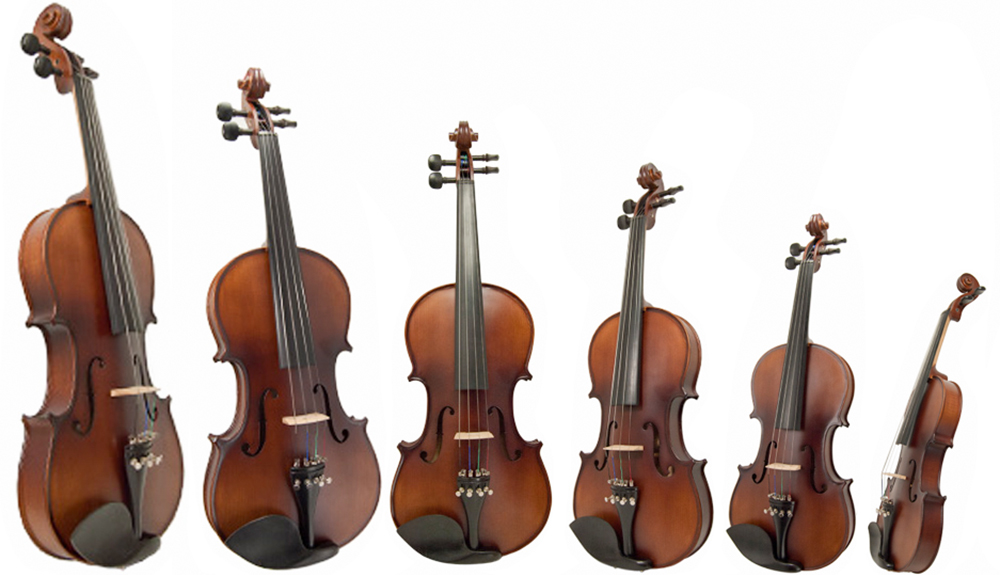When embarking on a musical journey as a begining violinist, choosing the right violin size is crucial. A well-fitted instrument not only ensures proper technique and comfort but also paves the way for a less difficult playing experience. In this ultimate guide, we will walk you through the key factors to consider when selecting the perfect violin size for a beginner player.
Understanding Violin Sizing:
Violins come in various sizes to accommodate players of different ages and physical proportions. The correct violin size allows beginners to hold and play the instrument comfortably, fostering proper posture and technique. Here are the standard violin sizes commonly available:
- 1/16 size
- 1/10 size
- 1/8 size
- 1/4 size
- 1/2 size
- 3/4 size
- 4/4 (full) size
Factors to Consider
Age and Physical Proportions:
- Very young children (4-5 years old) typically start with smaller sizes (e.g., 1/16 – 1/8) and gradually progress to larger sizes as they grow.
- Teenagers and adults generally use full-size violins (4/4), but it’s important to consider individual physical proportions as well.
Arm Length and Finger Placement:
- The player’s arm length, particularly from the neck to the middle of the palm, determines the appropriate violin size.
- Proper finger placement on the fingerboard relies on a comfortable reach, ensuring accurate intonation and technique. Pay particular attention to the 4th finger to ensure it can reach the proper place while still being at least slightly bent.
Comfort and Playability:
- Hold the violin and bow to test the overall comfort, balance, and weight distribution. A well-fitted violin should allow ease of movement and control.
Seek Expert Guidance:
- Consult a knowledgeable violin teacher, or an experienced shop representative, who can provide personalized recommendations based on your specific needs. As a general rule, a teacher or violin shop specializing in student instruments will be able to easily guide you to the proper size—either by looking at your child holding the violin or asking you some general questions about their age, experience level, and their average size for their age group.
Choosing the Right Violin Size:
Measurement Method:
- Use the neck-to-palm measurement technique: Extend the left arm fully perpendicular to the body, and measure from the base of the neck to the middle of the palm.
- Match the measurement to the corresponding violin size. Keep in mind that the students ability to maintain proper left hand technique is paramount. You can check out Kennedy Violins’ orchestral instrument sizing chart.
Playtesting:
- Visit a reputable violin shop or seek assistance from a knowledgeable violin teacher to try different violin sizes.
- Play each size to assess comfort, reach, and overall ability to reach all the notes in the left hand. Remember that stretching to a new size will be uncomfortable at first, but if they have proper form in their left hand, the 4th finger will tell you a lot. If they can reach and maintain proper technique (especially the 4th finger), the violin is probably not too big for them.
Renting vs. Buying:
- For young beginners with potential growth spurts, renting a violin is a very cost-effective option.
- If the player has stopped growing or shows long-term commitment, investing in a suitable-sized violin might be a better choice. Many shops have very good instrument trade-in programs.
Maintenance and Future Adjustments:
Remember, as a beginner, it’s important to check the violin’s size to see if it’s time for a larger size. It may be a good idea to check every 4-6 months.
Conclusion:
Choosing the right violin size for beginners sets the foundation for a comfortable and enjoyable musical journey. By considering factors such as age, physical proportions, comfort, and playability, you can make an informed decision that fosters proper technique and supports progress. Remember to seek guidance from experts if you have any questions!

Leave a Reply